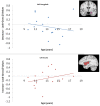How grossed out are you? The neural bases of emotion regulation from childhood to adolescence
- PMID: 21686071
- PMCID: PMC3113636
- DOI: 10.1016/j.dcn.2011.03.004
How grossed out are you? The neural bases of emotion regulation from childhood to adolescence
Abstract
The ability to regulate one's emotions is critical to mental health and well-being, and is impaired in a wide range of psychopathologies, some of which initially manifest in childhood or adolescence. Cognitive reappraisal is a particular approach to emotion regulation frequently utilized in behavioral psychotherapies. Despite a wealth of research on cognitive reappraisal in adults, little is known about the developmental trajectory of brain mechanisms subserving this form of emotion regulation in children. In this functional magnetic resonance imaging study, we asked children and adolescents to up-and down-regulate their response to disgusting images, as the experience of disgust has been linked to anxiety disorders. We demonstrate distinct patterns of brain activation during successful up- and down-regulation of emotion, as well as an inverse correlation between activity in ventromedial prefrontal cortex (vmPFC) and limbic structures during down-regulation, suggestive of a potential regulatory role for vmPFC. Further, we show age-related effects on activity in PFC and amygdala. These findings have important clinical implications for the understanding of cognitive-based therapies in anxiety disorders in childhood and adolescence.
Keywords: cognitive reappraisal; development; emotion regulation; functional magnetic resonance imaging.
Figures






Similar articles
-
vlPFC-vmPFC-Amygdala Interactions Underlie Age-Related Differences in Cognitive Regulation of Emotion.Cereb Cortex. 2017 Jul 1;27(7):3502-3514. doi: 10.1093/cercor/bhw073. Cereb Cortex. 2017. PMID: 27341851 Free PMC article.
-
Neural correlates of immediate and prolonged effects of cognitive reappraisal and distraction on emotional experience.Brain Imaging Behav. 2017 Oct;11(5):1227-1237. doi: 10.1007/s11682-016-9603-9. Brain Imaging Behav. 2017. PMID: 27709512
-
Neural systems for cognitive reappraisal in children and adolescents with autism spectrum disorder.Dev Cogn Neurosci. 2014 Oct;10:117-28. doi: 10.1016/j.dcn.2014.08.007. Epub 2014 Aug 19. Dev Cogn Neurosci. 2014. PMID: 25198094 Free PMC article.
-
Neurocognitive bases of emotion regulation development in adolescence.Dev Cogn Neurosci. 2015 Oct;15:11-25. doi: 10.1016/j.dcn.2015.07.006. Epub 2015 Jul 29. Dev Cogn Neurosci. 2015. PMID: 26340451 Free PMC article. Review.
-
Neural Circuitry of Impaired Emotion Regulation in Substance Use Disorders.Am J Psychiatry. 2016 Apr 1;173(4):344-61. doi: 10.1176/appi.ajp.2015.15060710. Epub 2016 Jan 15. Am J Psychiatry. 2016. PMID: 26771738 Free PMC article. Review.
Cited by
-
Influences of affective context on amygdala functional connectivity during cognitive control from adolescence through adulthood.Dev Cogn Neurosci. 2020 Oct;45:100836. doi: 10.1016/j.dcn.2020.100836. Epub 2020 Aug 14. Dev Cogn Neurosci. 2020. PMID: 32836077 Free PMC article.
-
Neural Activation During Cognitive Emotion Regulation in Previously Depressed Compared to Healthy Children: Evidence of Specific Alterations.J Am Acad Child Adolesc Psychiatry. 2015 Sep;54(9):771-81. doi: 10.1016/j.jaac.2015.06.014. Epub 2015 Jul 4. J Am Acad Child Adolesc Psychiatry. 2015. PMID: 26299299 Free PMC article.
-
The development of emotion regulation: an fMRI study of cognitive reappraisal in children, adolescents and young adults.Soc Cogn Affect Neurosci. 2012 Jan;7(1):11-22. doi: 10.1093/scan/nsr093. Soc Cogn Affect Neurosci. 2012. PMID: 22228751 Free PMC article.
-
Age-related changes in reappraisal of appetitive cravings during adolescence.Neuroimage. 2015 Mar;108:173-81. doi: 10.1016/j.neuroimage.2014.12.037. Epub 2014 Dec 20. Neuroimage. 2015. PMID: 25536500 Free PMC article.
-
vlPFC-vmPFC-Amygdala Interactions Underlie Age-Related Differences in Cognitive Regulation of Emotion.Cereb Cortex. 2017 Jul 1;27(7):3502-3514. doi: 10.1093/cercor/bhw073. Cereb Cortex. 2017. PMID: 27341851 Free PMC article.
References
-
- Aichhorn M., Perner J., Kronbichler M., Staffen W., Ladurner G. Do visual perspective tasks need theory of mind? Neuroimage. 2006;30:1059–1068. - PubMed
-
- Amaral D.G., Price J.L. Amygdalo-cortical projections in the monkey (Macaca fascicularis) J. Comp. Neurol. 1984;230:465–496. - PubMed
-
- Barbas H. Anatomic basis of cognitive–emotional interactions in the primate prefrontal cortex. Neurosci. Biobehav. Rev. 1995;19:499–510. - PubMed
Publication types
MeSH terms
Grants and funding
LinkOut - more resources
Full Text Sources
Miscellaneous

